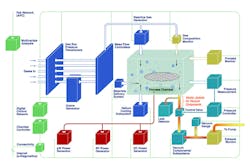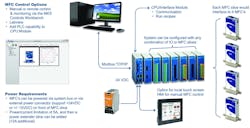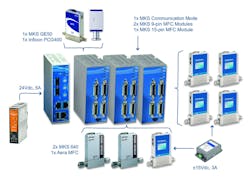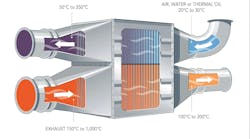Throughput, quality and cost have always been key technology and decision drivers in industrial automation and manufacturing. Today’s customers require complex automation solutions: Systems must be scalable and expandable to a number of environments. Systems and subsystems must be seamlessly integrated, and systems must be capable of meeting short delivery times.
The control architectures used in many manufacturing environments incorporate several independent subsystems that perform the material handling, processing, control, sensing and analysis functions required for any step of the overall manufacturing process. The subsystems may be supplied by one or more original equipment manufacturers. Optimized operation in the tool is most easily achieved when communication and control for all the subsystems are tightly synchronized. Unfortunately, subsystem equipment control is often configured in a piecemeal manner, using independent, tiered control schemes.
Typically, each subsystem controls only a fraction of the system’s devices, producing concomitant issues of redundancy and excessive cost in the operational characteristics of the process tool. Often, subsystem controllers do not easily communicate with each other, and integrating their operation with a tool’s PC/host is not an easy task. Furthermore, tiered subsystems typically provide only minimal capabilities for data logging, a critical drawback for advanced process control protocols. System tools using independent, tiered equipment control systems therefore present a risk for inefficient processing that requires significant manual interaction. This negatively impacts production line cost and yield.
Consider the semiconductor wafer process system (See Figure 1). This tool incorporates independent equipment and control nodes for, among other things, vacuum and pressure; gas flow; process chamber and vacuum line temperatures; plasma power supply; automated wafer handling; and for process data collection, communication and analysis. This single tool includes more than a dozen independent subsystems. Similar varieties and numbers of subsystems are found in process tools used in the manufacture of flat-panel displays, ultra-high vacuum coatings and solar energy products. Analogous equipment configurations also exist in the process tools operating in many different manufacturing environments, ranging from chemical processing to retail product manufacturing.
The implementation of safe and effective control of networks with multiple control nodes that maintain semi-autonomous local control over subsystem functions can be extremely challenging. Many approaches suffer from poor accuracy and precision.
These inadequacies arise from problems caused by latency delays, determinism/timing challenges at the local device level, and the centralized tool control level. The time and cost required for the implementation of effective safety protocols in the architectures of networks and local control nodes are also negatively impacted by the intricacies of current architectures.
Further complicating the control of modern process tools is the fact that advanced tool control protocols do not function in a reactive mode but proactively control multiple local control nodes to achieve intelligent and programmable control of the entire tool/process. Proactive operating philosophies couple early fault detection and classification with better process understanding, integrated control and automation functions to improve tool efficiency and safety and the need to lower a tool’s operating cost. Proactive control also facilitates reductions in a process’ environmental impact, simplifies the efforts needed to comply with government regulations, and helps eliminate the negative economic and branding costs associated with the release of faulty products to the marketplace.
The accurate, precise, well-synchronized and programmable control of different local modules for equipment functions is a prerequisite for proactive process control. The command information and sensor data needed for such synchronized control has to be transferred between master and subsystem controllers in real time or near real time. Real-time sensor data are also needed by the safety interlock system if a failure occurs since many process tools may be in contact with toxic, corrosive and pyrophoric chemicals; high temperatures; and/or high electrical voltages. Finally, with the modular architecture of most advanced process tools, all this control and communication must be duplicated for multiple process modules.
Network/Node-based control can be managed with a single, centralized automation platform capable of complete tool, process and distributed control. This type of control architecture reduces tool complexity by decreasing the number of microprocessor cores and operating systems used for control of the different tool functions. This approach to centralized control can be fast and deterministic while simultaneously being programmable, safe and secure. Centralized controllers for system tools also can significantly lower the cost of the control architecture when compared to existing approaches.
Modular automation solutions for flow measurement & control
Modern, modular automation systems seamlessly control the subsystems to create comprehensive system control with the following results:
Figure 2. Components of a modern modular automation platform
Modular systems provide a fully programmable, open-standard solution that is flexible and scalable. They merge the characteristics of programmable logic controllers (PLCs) with those of industrial personal computers (IPCs) to provide greater performance than PLCs or IPCs in a more compact, customizable and cost-effective package. Localized and high-speed input/output (I/O) control with local logic can be implemented in either a modular, DIN-rail-mountable enclosure for a single tool location or as an intelligent distributed node on a manufacturing line.
Libraries of process routine templates and function blocks can be built into these systems to facilitate faster implementation than is possible using more conventional, tiered control schemes. Modular automation platforms result in faster installations and shorter tool downtimes for the process tool, ultimately leading to reduced time to market for the users’ products.
Customers can leverage these platforms to integrate a fully automated solution in applications, such as programmability with multiple input, multiple output control, vacuum processes, environmental monitoring, LEDs, metal organic chemical vapor deposition, life sciences, safety interlocks, plastics and ceramics manufacturing, packaging, biopharmaceutical processing, and food and beverage processing.
The typical components (see Figure 2) include a programmable automation controller (PAC), a communications module and application-specific I/O modules. Advanced modular automation platforms directly interface to many control and sensing products — including mass flow controllers (MFCs), sensors, actuators, pressure gauges, valves and heaters — using standard fieldbus protocols such as EtherCAT, Ethernet/IP and Profinet. Non-Ethernet fieldbuses such as Devicenet and Profibus, and communication protocols such as Modbus and TCP/IP are also supported.
Process routine and logic development are performed via an IEC 61131-3-compliant programming interface and support the following programming languages:
Figure 3. Automation platform example for flow measurement and control
- Ladder logic
- Structured text
- Function block diagrams
- Instruction list
- Sequential function charts
Modular automation platforms enable fully programmable control for different manufacturers’ products, integrating and automating the sensors and devices present in a process tool, which enables faster installations and reduced tool downtimes. The control module directly interfaces to communications and fieldbus modules to integrate serial devices and sensors (RS232 and RS485); MFCs; Baratron pressure sensors; analog I/O — ± 5 volts (V), 0-5V, ± 10 V, 0 to 10 V, 0-20 milliamps (mA), 4-20 mA; discrete I/O valves (0 to 24 V); resistance temperature detectors/thermocouples; and heater outputs.
For flow measurement and control applications, MFC modules provide a compact and high-density solution for integrating MFCs with the automation platform’s PAC or communications and fieldbus modules. MFC modules support either 15- or nine-pin analog MFCs. The MFC module has a direct one-to-one pin mapping of the MFCs, so connected MFCs are fully powered and controlled through the MFC module. Each MFC module supports integrating four MFCs. With the exact matching pin-out for a standard cable, the MFC module simplifies cabling connectivity and lowers cost, providing comprehensive power, control and monitoring.
Pre-existing libraries of function blocks facilitate process logic development. The automation platform should also be capable of upstream integration with a control software resident on a host PC. Such software can be used to create custom dashboards that provide convenient and user-friendly graphical user interfaces for configuration, process monitoring and charting, tuning, and advanced control options. Figure 3 shows an overview of a typical modular automation platform implementation, in this case for the control of four MFCs. More advanced automation platforms can also be configured to support quality management
applications such as real-time multivariate analytics to support proactive control philosophies for prediction and containment of process defects. Additionally, modular automation platforms can be configured to support advanced control algorithms, such as (in the case of temperature control) model-based control, which provides significant improvements when compared to older control methods, such as common proportional-integral-derivative control.
Figure 4. Ethernet-based MFC control solution with PAC and Modbus TCP/IP master
The earlier example of the generic semiconductor process tool (see Figure 1) demonstrates the effective implementation of a modular automation platform in a practical process tool. Using the automation components in a modular automation platform, Figure 4 illustrates how modular control can be implemented in such a process tool using multiple communications and I/O modules that are interfaced to a single PAC. The schematic shows those areas at which a modular automation control solution can be used to integrate and synchronize the automation and control of gas flow, plasma power and process pressure sensing within the tool.
Case Study 1 — MFC control application
A gas sensor manufacturer required an Ethernet-based controller for a large number of MFCs. The controller was required to be flexible, programmable and cost-effective.
The combination of a single PAC and a Modbus TCP/IP master provided an effective solution for controlling 16 MFCs. The user achieved a programmable solution at a total solution cost of $1,500.
Figure 5. Modular automation platform solution for gas mixing application
Case Study 2 — Gas mixing
A user wished to automate the control of a gas manifold delivery system, interfacing different manufacturers’ MFCs with pressure sensing and control. The user had four independent controllers involved in this single gas delivery system.
A modular automation solution for the application (see Figure 5) included a single communication module, three MFC I/O slices and PC-based control software for remote process control and monitoring. Implementation of the modular automation platform solution produced an estimated cost savings of $10,000.
Case Study 3 — Ceramic manufacturing
Figure 6 shows a large, hot zone furnace used for ceramics manufacturing. To avoid associated contamination risks, the process uses sequential depositions while the parts are in the furnace. The user originally deployed individual manual controllers for each device, component or subsystem and wished to automate the temperature control, vacuum and pressure sensing and control, and gas flow control.
Following the adoption of the modular automation control platform, the user experienced many significant benefits, including the elimination of subsystem manual control, reductions in the number of failure points, simplified troubleshooting and significant cost savings from the reduction in the number of
control systems.
Figure 6. Automation control platform with MFCs for a ceramic treatment application
Conclusion
Modular automation platforms offer comprehensive, flexible, scalable and expandable solutions for process tool automation that improve operational and productivity efficiencies in many processing environments. These platforms enable synchronized subsystem connectivity and seamlessly interface to many subsystems and instrumentation, including:
- MFCs
- Remote plasma sources
- Vacuum quality monitor
- Radio-frequency and direct-current power generators
- Indirect pressure gauges
- Heater jackets
- Direct pressure gauges (capacitance manometers)
- Gas analysis solutions (Fourier transform infrared spectrometry and residual gas analyzers)
- Real-time multivariate analytics
- Experiment design
- Residual gas analyzers
- Optical gas analyzers
Modern modular automation platforms offer software for configuration, process monitoring, tuning and data storage in a host/PC environment with capabilities for local touchscreen, human machine interface for manual control. Advanced automation platforms can incorporate quality management/prediction systems to provide an entire solution for process monitoring and quality prediction using multivariate analysis technology. The advanced control and interfacing abilities of modular automation platforms provide users with significant advantages arising from reduced cost of equipment ownership and dramatic improvements in product quality and time to market.
Dan Hazen is a senior product marketing manager for the MKS Automation and Control Solutions division, where he leads the product management and development of automation solutions, leveraging advanced analytics in the medical, pharmaceutical, semiconductor, and automotive markets. Hazen has published and presented numerous articles on implementing advanced and embedded analytical solutions to eliminate defects, reduce equipment downtime and improve process performance and yields.







